Category: Food history
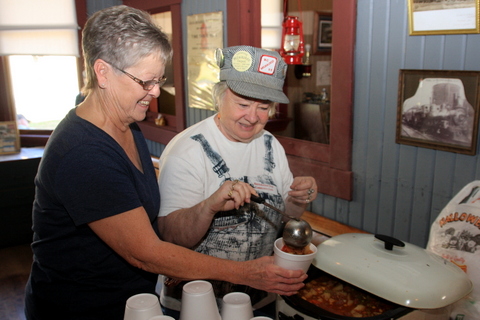
All Aboard! Rockwell City’s “Depot People” Offer a Taste of Iowa History
Eating like a hobo never tasted so good, at least when the “Depot People” are cooking. The savory aromas that emanate from the historic railroad depot in Rockwell City for one afternoon each fall signal that something good is coming down the line.
“I love this little museum and enjoy giving people a taste of the past,” said Carol Hupton of Rockwell City, president of the board of “Depot People” who have transformed the 1899 depot and freight shed into a museum.
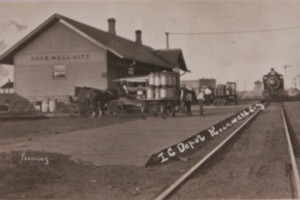
A train rolls into the Illinois Central Railroad depot in Rockwell City years ago.
During the annual fundraiser, which Hupton has helped with for the past six years, home cooking offers a feast at the Rockwell City depot a block north of the Calhoun County courthouse. Guests can dine on homemade hobo stew, hot dogs, homemade cookies, bars and more, with all proceeds going to restoration projects at the depot.
Saving the depot has been a labor of love for the Depot People, a group of about 25 people who want to preserve their community’s history. “There was a time when the depot was in danger of being torn down,” said Hupton, who has been volunteering with the depot museum for 10 years. “People don’t always realize the important role the railroad played to help Iowa and small towns like Rockwell City grow.”
The first railroad to arrive in Rockwell City was the Des Moines & Northern line, which was later taken over by the Chicago, Milwaukee & St. Paul Railway. The first passenger train rolled into town in 1881.
Rockwell City’s second railroad was the Illinois Central. Surveying the land between Fort Dodge and Rockwell City for this rail line began in 1899. Around 1903, the Newton and Northwestern Line, an interurban line, became the third rail line to Rockwell City. For decades, it brought passenger cars from Newton and Des Moines every two hours from 7 a.m. to 9 p.m.
During the heyday of the railroad, Rockwell City became a stop for multiple passenger trains and freight trains each day. Weary travelers could enjoy a meal at the nearby Hotel Brower or various restaurants in town.
In time, paved roads and interstate highways led to increased traffic from cars, pickup trucks and semi-trucks across Iowa and the nation, marking the end of an era for passenger trains. Railroad transportation itself changed as powerful diesel engines replaced the steam engines that once powered the many trains that rolled across the Iowa countryside. “Now the old depot here in town stands alone as a reminder of our history with the railroads,” Hupton said.
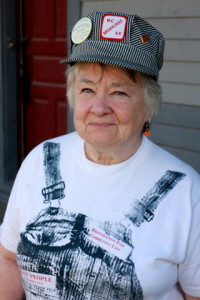 Sharing this history is important to Hupton and her fellow volunteers. The depot’s fundraising meal offers another way to encourage people of all ages to visit the museum. “Many kids don’t know anything about the history of the railroad in Rockwell City or other small Iowa towns,” Hupton said.
Sharing this history is important to Hupton and her fellow volunteers. The depot’s fundraising meal offers another way to encourage people of all ages to visit the museum. “Many kids don’t know anything about the history of the railroad in Rockwell City or other small Iowa towns,” Hupton said.
That’s why the Depot People have created historical exhibits in the depot, including vintage photos of the depot, to show the important role it once played in the community. A recreated hobo camp east of the freight shed also helps visitors learn how the railroad influenced people’s daily life in various ways.
The Depot People continue to apply for grants and host fundraisers with meals to preserve local railroad history. A summer car show allows car, truck and motorcycle fans to display their prized vehicles, while guests can dine on pulled pork sandwiches, potato chips, homemade desserts.
In the fall, the depot becomes an informal dining room where guests can enjoy a hearty bowl of homemade hobo stew, sugar cookies, salted nut roll bars and other goodies prepared by some of Rockwell City’s best cooks and depot supporters, including Maurine Zuetlau.
“Rockwell City’s depot is a landmark,” Hupton said. “We’ll continue to do what we can to preserve this local history.”
Savor more Iowa food history
Want more fun Iowa food stories and recipes? Check out my top-selling “Culinary History of Iowa” book from The History Press, and order your signed copy today.
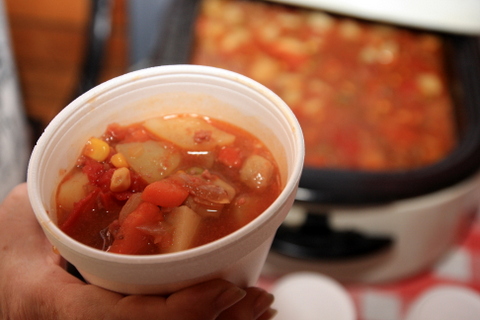
Hearty Hobo Stew from Iowa
Hearty Hobo Stew
4 pounds rump roast, cut up into cubes
Olive oil
2 cups diced celery
1 1 / 2 cups carrots, sliced
2 cups apple-cider vinegar
2 cups French onion condensed soup
3 to 4 cups potatoes, cubed and cooked
2 cans diced tomatoes
Beef stock (use as much as desired for the right consistency of stew)
Corn kernels, optional
Peas, optional
Brown the cubes of beef in olive oil. Combine beef with remaining ingredients. Place stew in roaster and cook until heated through.
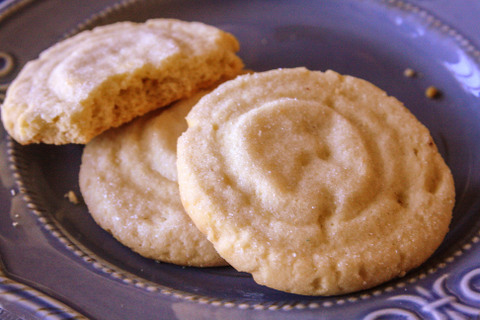
Homemade Sugar Cookies
World’s Best Sugar Cookies
These Amish sugar cookies come from Maurine Zuetlau of Rockwell City.
1 cup powdered sugar
1 cup granulated sugar
1 cup butter (can use half butter and half margarine)
1 cup vegetable oil
2 eggs
2 teaspoons vanilla
1 teaspoon salt
1 teaspoon cream of tartar
1 teaspoon baking soda
5 cups flour
Mix all ingredients. Roll dough into balls to form each cookie. Roll each dough ball in granulated sugar. Press down each ball with a glass dipped into granulated sugar. Bake cookies at 350 degrees for 13 to 15 minutes. Let cool on cookie sheet 2 to 3 minutes. Remove cookies and place on cooling rack.
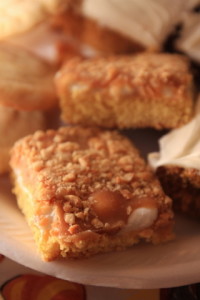
Salted Nut Roll Bars
Salted Nut Roll Bars
These tasty bars are reminiscent of salted nut roll candy bars and come from Maurine Zuetlau of Rockwell City.
1 package yellow cake mix
1 / 2 cup softened margarine
1 egg
3 cups mini marshmallows
2 / 3 cup white corn syrup
1 / 4 cup margarine
1 12-ounce package peanut butter chips
1 cup chopped, dry-roasted peanuts
Combine cake mix, 1 / 2 cup margarine and egg. Pat mixture into 9-inch by 13-inch pan. Bake at 350 degrees for 18 to 20 minutes. Cover bars with marshmallows. Return to oven for 2 to 3 minutes. (Marshmallows will puff up.) Cool.
Boil white corn syrup and 1 / 4 cup margarine. Remove from heat. Add peanut butter chips. Pour mixture over marshmallows and top with nuts. Cool completely, cut into bars.
P.S. Thanks for joining me. I’m glad you’re here.
@Copyright 2016 Darcy Maulsby & Co.
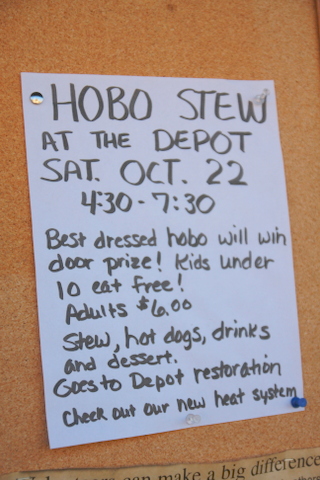
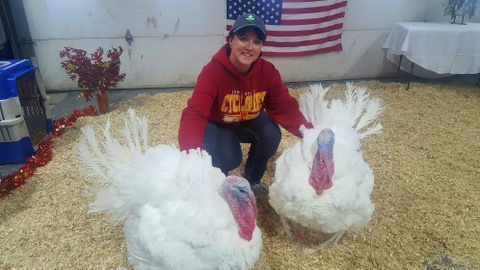
Iowa Turkeys Carry on National Thanksgiving Tradition
They strut around their little area of the farm with a certain air about them. Nothing ruffles their feathers. These two pristine, white Sac County turkeys (named Tater and Tot) are special—and they know it.
“We’re honored that the national Thanksgiving turkeys hailed from Iowa this year,” said Gretta Irwin, executive director of the Iowa Turkey Federation. “These turkeys are a symbol of plenty and are a great celebration of Iowa agriculture.”

Tater and Tot make their Washington, D.C. media debut in the ballroom of the famous Willard Hotel on Nov. 22, 2016.
Through nearly seven decades, the President of the United States has received a turkey from the National Turkey Federation during Thanksgiving week. As part of the White House event, recent custom has the president “pardoning” the turkey, after noting the significance of a time of thanks for the nation’s many blessings and the opening of the holiday season.
Two turkeys are selected each year for this prestigious—if quirky—honor. One turkey functions as the “backup” in case the first turkey can’t complete its duties as the national Thanksgiving turkey. This year’s presidential turkeys hailed from Chris and Nicole Domino’s farm northwest of Early. The 42-pound male birds were born July 18 and were selected in August for their famous role.
“They had some of the best-looking feathers and the best personalities, because they are very calm,” said Chris Domino, a fourth-generation farmer who has raised turkeys for nine years. “They really stood out from the crowd.”
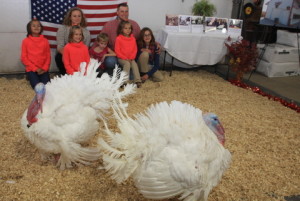
Chris and Nicole Domino and their five daughters raised Tater and Tot on their Sac County, Iowa, turkey farm.
Groomed for greatness
The presidential turkeys received plenty of personalized care during their months at the Domino’s farm, thanks to daughters Adrian, 13; Brianna, 10; Marissa, 8; Addison, 7; and Megan, 6. The male turkeys got their first taste of celebrity with the snacks they were offered. “We tried lettuce, cottage cheese and cooked eggs, but we found out the turkeys love dried meal worms and diced tomatoes,” Chris Domino said.
The birds enjoyed other perks, too, including dog toys. “They like playing with tugs and squeaky dog toys,” said Adrian Domino, who helped raise the birds with the help of her parents and sisters.
The five girls lavished attention on the turkeys and didn’t stop with special treats. They washed the birds and even played music for them. The first song to elicit a gobble from the turkeys? “Me, Too” by pop singer Meghan Trainor.
The turkeys got their first taste of fame on the morning of Nov. 18, when the Iowa Turkey Federation hosted a send-off for the birds. A small group of local and state media, turkey industry representatives and elected officials from Sioux City to Des Moines gathered in a shed at the Domino family’s farm to “meet” the celebrities and learn more about the Domino family’s farming tradition, which has spanned nearly a century.
“We highlight the family aspect of farming as we celebrate this fun, turkey-centered tradition,” Irwin said.
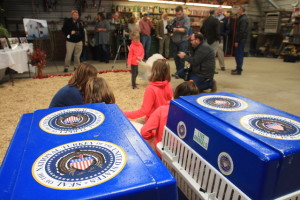
The official presidential turkey carriers are ready to transport Tater and Tot from their farm near Early, Iowa, to Washington, D.C.
Turkey tradition dates back to Truman administration
The turkeys left for Washington, D.C. in a van early in the week of Nov. 21. After arriving in the nation’s capital, they settled into their deluxe accommodations at the posh Willard Hotel just down the street from the White House.
Irwin and the Dominos watched as the Iowa turkeys basked in the spotlight during a high-profile media event at the Willard Hotel ballroom on Nov. 22. The big day arrived on Nov. 23, when President Obama bestowed names on the birds and issued his pardon for the turkeys, who were presented by National Turkey Federation Chairman John Reicks. The birds retired to Virginia Tech University, where they will live out their lives in comfort.
While some historians debate the origins of the presidential Thanksgiving turkey tradition, history is clear that the first presentation of a turkey by the National Turkey Federation occurred during President Truman’s administration.
Since then, Iowa has supplied seven of the Thanksgiving turkeys pardoned by various presidents. Prior presidential turkeys have hailed from Ellsworth, West Liberty, Dike and Story City. The birds have represented Iowa during the administrations of President Johnson (1964), President Ford (1976), President Reagan (1983 and 1988), President George Herbert Walker Bush (1991), George W. Bush (2008), and now Obama in 2016.
Congressman Steve King (R-Iowa) noted that 2016 marks the first time a presidential bird has come from his congressional district. He added that Benjamin Franklin wanted the turkey to be America’s national bird. “Turkey production is a form of value-added agriculture and reminds us that all new wealth comes from the land,” King said. “It’s a proud tradition that’s worth honoring as this country comes together for Thanksgiving.”
Savor more Iowa food history
Want more fun Iowa food stories and recipes? Check out my top-selling “Culinary History of Iowa” book from The History Press, and order your signed copy today.
P.S. Thanks for joining me. I’m glad you’re here.
@Copyright 2016 Darcy Maulsby & Co.


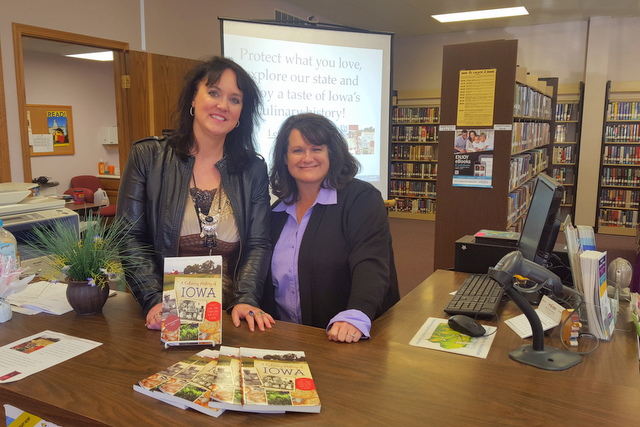
Iowa Eats! Why Radio Iowa, Newspapers and Libraries are Hungry for “A Culinary History of Iowa”
Everyone has an Iowa food story, even those doubters who sounded incredulous when I first proposed my idea for my “Culinary History of Iowa” book. Their amusement, followed by the inevitable question, “Iowa has a culinary history?” quickly dissolved into stories of Maid-Rites, potlucks and more.
The media, Iowa libraries and others across the state have really embraced these stories, too. I was honored to offer book programs and signings at the Ruthven Public Library and beautiful Kendall Young Public Library in Webster City. I was also pleased that the Webster City Freeman Journal ran a feature story on my book, at Pat Powers from KQWC Radio in Webster City interviewed me in a broadcast that has now popped up on Radio Iowa.
Need a fun read or a great gift idea? Click here to visit my online store, where you can purchase copies of “A Culinary History of Iowa,” a unique set of 15 vintage images from “A Culinary History of Iowa,” and my first book, “Calhoun County,” which shares the remarkable, illustrated history of small-town and rural Iowa through the eyes of those who lived it.
November 19th, 2016 by Ric Hanson
http://www.kjan.com/index.php?cat=3&paged=2
From pork tenderloins to sweet corn to Jell-o, a new book is out focused on Iowa foods and the flavors that make the state so delicious. The book, “A Culinary History of Iowa,” traces the popular tastes of Iowans through the years, according to author Darcy Dougherty Maulsby, of Lake City. “We do have great cuisine,” Maulsby says. “It’s funny. When the book came out, I had some people questioning, ‘Iowa has a culinary history?’ We sure do. I said, ‘Just starting thinking what defines Iowa food,’ and everybody always comes up with an answer.” Maulsby says she’s done research for the book by exploring all four corners of the state and everything in between.
“I’ve been working on it in bits and pieces for almost 20 years in my career as an ag journalist,” Maulsby says. “I’ve traveled the state and met with some of Iowa’s finest chefs and lots of great old-school farm cooks. I’ve seen the spectrum of really awesome Iowa food and it’s been so much fun to collect all of these stories and photos in one place.” Some might categorize it as a cook book but Maulsby says it’s more than that.
“It’s the story behind the things that define Iowa food,” Maulsby says. “Whether that’s Maid-Rites, Dutch letters from Pella, there’s so many fun stories, Laura Ingalls Wilder turns up in there, the Younkers Tea Room, all of these amazing traditions, meat lockers, sweet corn, all of the things that make Iowa food great.” Find the book at the Amazon and Barnes & Noble websites as well as at: www.darcymaulsby.com. (Radio Iowa)
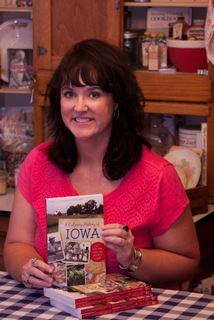
Darcy Maulsby is the author of “A Culinary History of Iowa,” which serves up stories, photos, recipes and more!
Iowa Eats: Maulsby pens book on the state’s culinary history
NOV 16, 2016
by ADRI SIETSTRA, Webster City Freeman Journal reporter
asietstra@freemanjournal.net
Author Darcy Maulsby will be bringing Iowa food stories to life during a free program Thursday evening at 6:30 p.m. at Kendall Young Library. The program will feature a cooking demonstration with book signing to follow.
“You’ll love this fun, fast-paced program filled with stories, rare vintage photos and surprising recipe tips. Be prepared to dig into the remarkable stories behind Iowa classics like Maid-Rites, breaded pork tenderloins, Iowans’ obsession with Jell-O, and our distinctive chili-and-cinnamon roll phenomenon,”said Maulsby. “I’ll also share practical, proven tips on how to preserve your own family’s history and food traditions.”
Maulsby, 43, is a self-described foodie and home cooking enthusiast from Lake City. She began baking and cooking in grade school while growing up on the farm. She entered many cooking contests at the Calhoun County Expo while a member of the Lake Creek Go-Getters 4-H Club.
“Food writing is a large part of my work as a small-business owner, freelance writer and marketing specialist who focuses on agriculture. I work with clients ranging from the National Pork Board to Farm News, where I often interview chefs and home cooks, create recipe pages and write feature stories that highlight the farm-to-fork connection,” said Maulsby.
In 2007, Maulsby completed the Master Food Preserver course through University of Illinois Extension. She earned her bachelor’s degree in journalism/mass communications and history from Iowa State University (ISU) and also earned her master’s degree in business administration from ISU.
Maulsby’s jams have won blue ribbons at the Iowa State Fair, and cookies have earned top honors at the Clay County Fair. She is also a certified Kansas City Barbecue Society judge.
Maulsby credits a variety of sources for the inspiration for her new book.
“The stories in “A Culinary History of Iowa” have come from the Iowa State Fair, as well as long-time restaurant owners, experienced farm cooks, candy shop owners and other foodies throughout Iowa,”Maulsby said.
Maulsby is excited to share some of Iowa’s culinary history with attendees Thursday evening.
“Everyone has a food story. Sometimes we don’t realize just how unique-and tantalizing-Iowa’s food traditions are. If you like to travel, you’ll walk away from this program inspired to explore Iowa, where you can sample flavors from around the globe without leaving the state,” said Maulsby. “If you have an appetite for adventure, you can’t do better than Iowa when it comes to history, agriculture and one-of-kind culinary experiences.”
Signed copies of her book “A Culinary History of Iowa” will be available for $24 a copy.
Celebrating great Iowa eats
LINDSAY ANDERSON, Kendall Young Librarian
 We Midwesterners are known far and wide for our excellent, down-home cuisine. Having only lived in Iowa for two years, I have already eaten enough to be amazed at Iowa’s particular brand of culinary delights.
We Midwesterners are known far and wide for our excellent, down-home cuisine. Having only lived in Iowa for two years, I have already eaten enough to be amazed at Iowa’s particular brand of culinary delights.
Have you ever wondered why Iowans cook – and eat – so well, and from where your signature recipes and food traditions originate? Iowa author and Lake City native, Darcy Maulsby, explores these and other food stories in her recently published book, Culinary History of Iowa. In it, she discusses everything from Maid-Rite classics to Iowan’s homemade cinnamon rolls (served with chili, of course). The Library is delighted to be hosting Maulsby at Kendall Young Library on Thursday, November 17 at 6:30pm for a presentation, book signing and cooking demonstration. Maulsby has been featured in the Iowa History Journal, Our Iowa magazine, Iowa Public Radio, and more. During Maulsby’s fun, interactive program, she will serve up fascinating tidbits related to more than 150 years of Iowa cuisine from all corners of the state. Attend this free event and discover how Iowa’s delectable cuisine is quintessentially Midwestern, grounded in its rich farming heritage and spiced with diverse ethnic influences.
On the Shelf
If all this talk of food has left you hungry, here are some titles that can help get some great, local Iowa eats cooking in your kitchen: The following cookbooks were recently added to the Library’s Genealogy Reference collection. While we do not allow these unique cookbooks to be checked out, you are welcome to browse them and make copies of any recipes that catch your eye.
The Famous Old Webster City Cook Book
Curated by The Ladies’ Aid Society of the Congregational Church in 1916, this cookbook boasts only “tried and tested” local recipes, including everything from waffles and pancakes, to salads and corn breads. A fun addition: the past page of this cookbook includes “Discoveries and Household Hints,” a delightful list of tips and tricks from some early 1900s kitchen experts.
4-H & Friends Cookbook
Assembled in honor of the Hamilton County 4-H program’s 70th anniversary in 1987, this nearly 400-page volume is painstakingly indexed, and boasts over 13 sections of recipes. Explore and discover some delightful gems; experiment with recipe choices ranging from “Shoo-Fly Cake” to “Gramma’s Hamburger Soup”.
St. Paul’s Lutheran Church Anniversary Cookbook
Compiled by the ALCW of St. Paul’s Lutheran Church of Williams, Iowa in 1987 to commemorate their 75th anniversary, this volume boasts more than 250 pages of hardy, time-tested eats that will satisfy your hunger and delight your taste buds. Try your hand at everything from “Buttermilk Cinnamon Bars,” to “Zucchini Date Pecan Loaf,” to “Highbrow Haddock.”
Try out these locally celebrated recipes for some delicious mealtime fun, and don’t forget to join us at the Library with Darcy Maulsby on Thursday, November 17 at 6:30pm for an unforgettable (not to mention delicious) journey into Iowa’s culinary past.
Order you copies today!
Click here to visit my online store, where you can purchase copies of “A Culinary History of Iowa,” a unique set of 15 vintage images from “A Culinary History of Iowa,” and my first book, “Calhoun County,” which shares the remarkable, illustrated history of small-town and rural Iowa through the eyes of those who lived it.
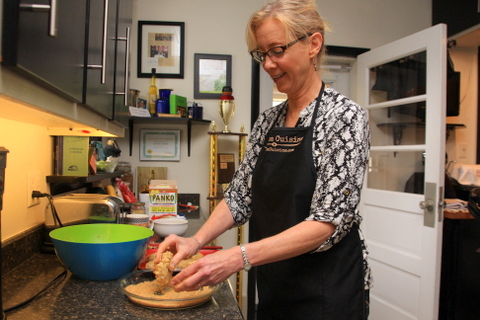
Rustic Cooking Refined: Iowan Robin Qualy Embraces Global Flavors
Call her a fusion of culinary creativity. While Robin Qualy has a strong German heritage, she loves Italian flavors. Although she didn’t care for home ec (now family and consumer sciences) classes during her school years in Lytton, Iowa, this self-taught cook loves to experiment in the kitchen. Most of all, she’s proud of her farm roots but takes a distinctly non-traditional approach to Iowa cooking.
It all started with a magnum of French champagne. “It was a gift from a client in Europe,” said Qualy, a court reporter who lives in Lake City, Iowa. “It sounded fun to have a crab fest with the champagne, so we did.”
The event evolved into a seafood fest with everything from clam chowder to crab cakes with remoulade (pronounced “rem-oo-laud”) sauce. “Finding Emeril Lagasse’s remoulade sauce recipe was a breakthrough,” Qualy said. “While it had 18 ingredients, it showed me why chefs’ food tastes so good, because everything is built up from all those layers of ingredients.”
This also inspired Qualy’s passion for showcasing global flavors. One of her favorite cookbooks is Marcella Hazan’s “Marcella Cucina,” which is filled with Italian recipes and interesting stories. Some of Qualy’s creations, including Pain D’Epi, a wheat-stalk bread inspired by French baguettes, can take on a variety of flavors, from Italian to Greek. This offers her customers options if Qualy happens to be selling her baked goods at the Lake City Farmers Market or the Clear Lake Farmers Market.
Qualy’s goal for this winter? Learn to prepare sushi. Through her part-time business, La Casa Cuisine, where she serves as an in-home guest chef, Qualy also enjoys sharing her best cooking tips, which include “reduce, reduce, reduce” to remove excess moisture and concentrate the flavors in sauces, “fresh, fresh, fresh” for everything from herbs to coffee beans, and “healthify” recipes by using more whole grains and vegetables, less sugar and healthier oils like olive oil.
By adding plenty of vegetables, Qualy “healthified” her chili recipe and took top honors in the 2016 Dell Blair Memorial Chili Cook-Off at Lake City’s fall festival this September. “This contest has been around for a number of years, so I knew I needed to offer something unique,” said Qualy, a first-time competitor. “Since there was no meat in the recipe, I used chipotle peppers in adobo sauce to add a hearty, smoky, spicy base.”
Sharing her culinary creations with friends and family is important to Qualy, who credits her mother, Marlene Glasnapp of Lytton, for inspiring a love of family, food, cooking and baking. Qualy’s advice to other home cooks? “Keep learning, and have fun refining your culinary techniques. Cooking is a skill you can use all your life.”
Savor more Iowa food history
Want more fun Iowa food stories and recipes? Check out my top-selling “Culinary History of Iowa” book from The History Press, and order your signed copy today.
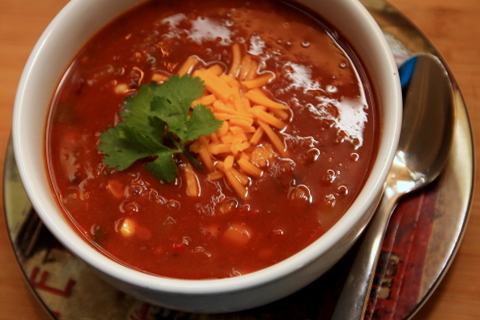 Championship Veggie Chili
Championship Veggie Chili
Robin Qualy’s unique chili won top honors in the 2016 Dell Blair Memorial Chili Cook-Off in Lake City this fall.
2 tablespoons canola oil
1 cup onion, diced
2 cups zucchini with skin, diced
1 / 2 cup red peppers, diced
1 / 2 cup yellow peppers, diced
1 / 2 cup orange pepper, diced
1 / 4 cup poblano or jalapeno pepper, diced (to taste)
2 teaspoons fresh garlic, minced
1/2 teaspoons salt
1/2 teaspoons black pepper
1 tablespoons cumin
2 tablespoons chili powder (to taste)
1 tablespoons sugar
1 box (32 ounces) unsalted vegetable stock (Qualy recommends the Kitchen Basics brand)
28-ounce can crushed tomatoes
28-ounce can garlic-celery-onion stewed tomatoes, diced or mashed
1 can green chilis, diced
2 tablespoons chipotle peppers in adobo sauce, diced
2 ears of sweet corn cut off cob, or 1 cup frozen corn, thawed
14-ounce can each white kidney, red kidney, and black beans – drained, rinsed, and mashed with potato masher
14-ounce can each white kidney, red kidney and black beans – drained and rinsed
In large pot, heat oil over medium heat. Add the onion and zucchini, cook about 5 min., then add peppers and garlic. Cook 5 more minutes. Add salt, pepper, cumin, chili powder and sugar. Cook until onion is translucent and zucchini is soft.
Pour in vegetable stock, crushed tomatoes, stewed tomatoes, green chilis and chipotle peppers in adobo sauce. Bring to boil, then reduce heat. Cover and simmer for 30 minutes. Add sweet corn, mashed beans and whole beans. Stir well; simmer another 30 minutes. Taste and adjust seasoning. Serve with shredded extra-sharp cheddar, snipped cilantro and blue corn chips. Ole! Ole! Ole! Yield: 1 gallon
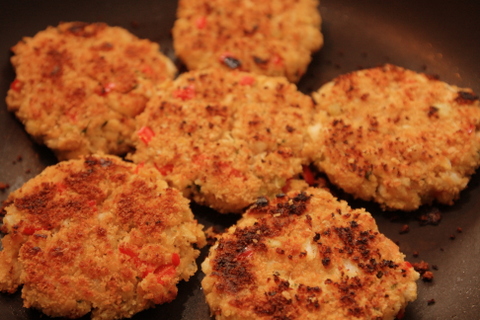 Crab Cakes with Remoulade Sauce
Crab Cakes with Remoulade Sauce
For the crab cakes:
2.5 cups crushed dry bread crumbs
3 6-ounce cans crab meat
1 / 3 cup salad dressing, Miracle Whip or mayo
1 / 2 cup red pepper, diced
2 stalks celery, diced
1 / 3 cup onion, diced
4 shakes of Louisiana hot pepper sauce (to taste)
2 teaspoons Old Bay seasoning
1.5 tablespoons lemon pepper seasoning
1 / 2 teaspoon salt
1 / 2 teaspoon black pepper
2 eggs
2 cups panko bread crumbs
Canola oil to generously coat surface of non-stick skillet
Combine bread crumbs, crab meat, salad dressing, red pepper, celery, onion, hot pepper sauce, Old Bay seasoning, lemon pepper, salt and black pepper. Taste test and adjust seasonings, as desired.
Add 2 eggs, lightly beaten. Form mixture into 10 2.5-inch patties. Firmly coat each crab cake with panko crumbs in pie plate. Heat canola oil until medium hot. Patties should sizzle when touching oil. Fry five patties at a time, 5 minutes per side, or until dark brown. Keep warm until serving with remoulade sauce on the side. Yield: 10 crab cakes
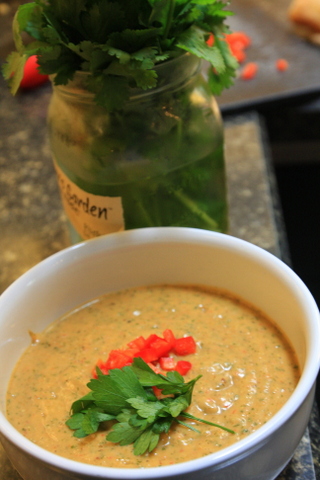 Remoulade sauce
Remoulade sauce
1 cup salad dressing or Miracle Whip
1 / 4 cup ketchup
2 tablespoons extra virgin olive oil
2 tablespoons whole-grain mustard (such as whole-grain Dijon)
2 tablespoons horseradish
1 tablespoon Louisiana hot sauce
2 tablespoon lemon juice
2 tablespoons Worcestershire sauce
1 / 4 cup scallions (or regular onions), diced
1 / 3 cup celery, diced
1 / 2 teaspoon fresh garlic, minced
2 tablespoons fresh parsley, chopped
1 teaspoon Cajun seasoning
1 teaspoon Old Bay seasoning
1 teaspoon dill weed
1 / 2 teaspoon black pepper
2 teaspoons brown sugar
Blend all ingredients, using a blender or food processor with S-shaped chopping/blending blade. Pour into bowl, cover and refrigerate. Best when served at room temperature. Laissez les bons temps rouler! (Let the good times roll!)
Beef Asian Stir Fry
Brown sugar is a secret ingredient in this flavorful stir fry.
1 pound lean steak (charcoal steak is a good option), sliced thinly against the grain into 2-inch-long strips
1 / 3 cup teriyaki sauce (liquid)
2 tablespoons canola oil for stir-frying
2 cups carrots, sliced
1 / 2 cup red peppers, sliced
8 ounces baby bella (cremini) mushrooms (one box), sliced
1 / 3 cup onion, sliced fairly big
1 / 2 of a fresh jalapeno pepper, seeded and deveined, small dice
8 ounces pea pods (can also substitute fresh green beans or broccoli florets)
1 8-ounce can bamboo shoots
1 8-ounce can water chestnuts, sliced
1 can baby corn
1 / 2 teaspoon fresh garlic, minced
1 / 2 teaspoon fresh ginger, grated (keep fresh ginger in freezer)
1 beef & broccoli seasoning packet (usually found near the gravy mixes in the grocery store)
1 cup water
6 tablespoons low-sodium soy sauce
1 / 2 cup teriyaki baste & glaze (thick consistency)
1 tablespoon cornstarch
2 tablespoons brown sugar
Red pepper flakes, as desired, for heat
Chopped cilantro, as desired, for flavor
8 ounces spaghetti, cooked and drained, or cooked rice
Marinate sliced beef in teriyaki sauce for 30 minutes to 1 hour. Heat oil in wok or large skillet to medium high. Add beef and stir-fry until almost fully cooked. Remove and set aside.Add more oil if needed. Stir-fry carrots, red peppers, mushrooms, onion, jalapeno, pea pods, bamboo shoots, water chestnuts and baby corn until crisp-tender. Do not overcook the vegetables.
Note: if fresh green beans are substituted for pea pods, slice the beans on the diagonal. If using broccoli, do not add until the very end. Microwave broccoli until crisp-tender. Using the microwave method allows you to control the broccoli doneness, and keeps it bright green.
Add garlic and ginger, and stir-fry another minute.
In a separate bowl, whisk the contents of the beef & broccoli packet, water, soy sauce, teriyaki thick sauce, cornstarch and brown sugar until combined; add to hot wok mixture. Add beef. Cook until hot and bubbling.
If using spaghetti, stir in drained spaghetti and combine. If using rice, do not combine with stir-fry mixture, but serve separately. Taste and adjust seasonings and heat. Use red pepper flakes or jarred jalapeno juice to increase heat. Top with cilantro, if desired. Serves 4.
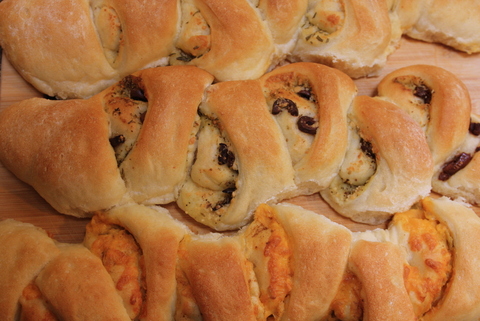 Pain D’Epi—Wheat Stalk Bread
Pain D’Epi—Wheat Stalk Bread
This French-style bread can take on a variety of flavors, depending on the ingredients you add. Break off bite-sized pieces during the meal, and freeze the leftovers.
Prepare baguette dough:
1.5 cups warm water
1.5 tablespoons granulated sugar
1.5 tablespoons olive oil
4 cups bread flour
1 teaspoon kosher salt
2 teaspoons fast-rise (bread machine) yeast
Add ingredients to bread machine; let the machine handle the mixing and first rise.
Spray countertop with cooking oil spray. Take dough out of bread machine and place on counter. Let dough rest 15 min. Divide into three portions.
Greek Pain D’Epi
2 teaspoons olive oil
1 teaspoon Greek seasoning (Cavender’s is a good option)
8 Greek olives (Kalamata olives), sliced
2 tablespoons dry Parmesan cheese
Italian Pain D’Epi
2 teaspoons olive oil
One 6-inch length of fresh rosemary stripped and chopped (or 2 teaspoons dried rosemary)
2 tablespoons dry Parmesan cheese
Roll dough out with rolling pin to 14-inch by 5-inch shape. Pour on olive oil, sprinkle on other ingredients to make either the Greek or Italian Pain D’Epi. (Recipe yields three loaves.)
Roll up dough so it’s 14 inches wide. Pinch to seal. Place dough on parchment-lined 11-inch by 17-inch cookie sheet (up to three bread loaves fit per cookie sheet). Using kitchen shears, make six cuts at a 45-degree angle to within half an inch of bottom of dough. Position each cut dough section in the opposite direction, keeping bottom of dough intact.
Cover with flour-sack cloth, or spray plastic wrap with cooking oil spray and cover. Let dough rise 45 minutes. Place pan in middle of preheated 425-degree oven. Mist inside of oven with water to create steam. Bake for 17 to 23 minutes, or until lightly browned. Serve warm with olive oil for dipping.
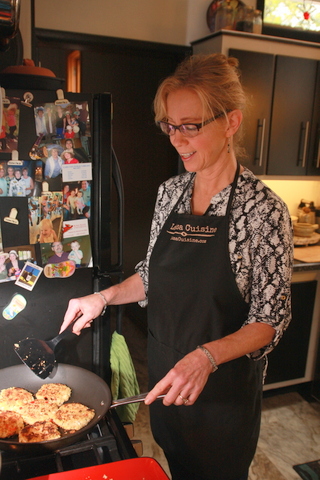 Chicken Piccata
Chicken Piccata
3 tablespoons extra virgin olive oil
2 boneless, skinless chicken breasts, butterflied and pounded to approximately one-quarter inch thickness
Salt and pepper, to taste
Lemon & Butter Cream Sauce for Chicken Piccata
4 tablespoons butter
3 tablespoons shallots, minced
1 pound baby bella (cremini) mushrooms, sliced
1 / 3 cup white wine (Chardonnay is a good option)
1 tablespoon capers
1 / 4 cup lemon juice
1.5 tablespoons cornstarch
1 14-ounce can chicken broth or stock
3 / 4 cup heavy cream or half-and-half
Salt and pepper, to taste
1 pound angel hair pasta, cooked, drained and buttered
Parmesan or asiago cheese
Heat a generous amount of oil in large skillet over medium heat. Salt and pepper the chicken; sauté for approximately three minutes per side. Set cooked chicken aside, covered in foil, on baking sheet in 275-degree oven. Continue sautéing all the chicken and place in oven.
Add butter to drippings in the skillet. Sauté shallots and mushrooms 5 to 7 minutes until browned. Increase heat and add wine, boiling 2 minutes to reduce the liquid. Add capers and lemon juice; simmer two minutes. Dissolve cornstarch in chicken broth and add to pan. Boil mixture down for two to three minutes. Reduce heat and whisk in cream. Simmer until sauce thickens slightly.
Place chicken on pasta and ladle sauce over half the plate, top with Parmesan or asiago cheese.
Serves 4.
This article first appeared in Farm News, Oct. 2016
P.S. Thanks for joining me. I’m glad you’re here.
@Copyright 2016 Darcy Maulsby & Co.
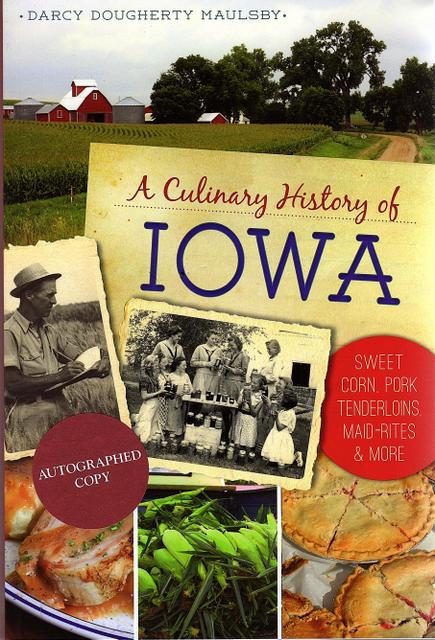
Talking Iowa Food and Culinary History on Iowa Public Radio
What do you think of when you think of Iowa food? Charity Nebbe explored Iowa’s amazing culinary history with me during “Talk of Iowa” on Iowa Public Radio recently, and you won’t believe all the incredible stories we covered in 20 minutes!
Listen to the complete “Talk of Iowa” interview about “A Culinary History of Iowa here.
Want to learn more about the book or its companion postcard packet of 15 vintage Iowa culinary history images? Check out my online store!

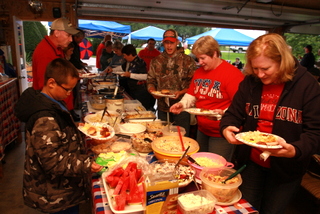
Remembering Sept. 11: Iowa Community’s Potluck Honors America
I wrote this story in 2014 for Farm News and wanted to share it again today on this 15th anniversary of the 9/11 tragedies. We must never forget, or take our freedoms for granted.
Ginger Tribby doesn’t do a lot of cooking. That doesn’t mean that incredible home-cooked food doesn’t abound, however, when she and her husband, Neal, host a potluck at their home each Sept. 11 to remember the day America changed forever.
“It’s about a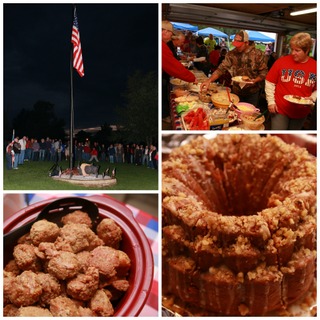 ppreciating our life, our freedom and all the blessings we have in America,” said Tribby, a retired Farm Bureau Financial Services employee.
ppreciating our life, our freedom and all the blessings we have in America,” said Tribby, a retired Farm Bureau Financial Services employee.
The Tribbys have hosted up to 200 guests for the annual Sept. 11 remembrance gathering—an impressive number for a community with about 110 people. The event offers a meaningful way to bring the community together, said Dorothy Gavin of St. Marys, who prepares a variety of dishes for the potluck. “We come together to honor those who perished, as well as the firefighters and first responders.”
The remembrance gathering started after Tribby, her husband, her sister Margie and brother-in-law Chuck were waylaid in Ireland following the attacks on Sept. 11, 2001. “We’d spent 10 days in Ireland celebrating our 25th anniversary,” Tribby recalled. “After we boarded a plane in Dublin on Sept. 11 to fly back to America, we heard there was going to be a slight delay.”
The passengers were later told that their flight had been cancelled due to the closing of U.S. air space. Amidst the fear and confusion, a fellow passenger with a cell phone was able to find out what was going on. “It was totally surreal,” said Tribby, who wasn’t able to return to the United States with her family until Sept. 15.
In 2002, the Tribbys decided to host a get-together on Sept. 11 to honor America. “It started as a small gathering,” Tribby said. “Then we thought maybe we should do this each year, so we have.”
The event has grown each year and includes people of all ages, from children to grandparents. Following an evening potluck meal featuring smoked pork loin, ham balls, cheesy potatoes and salads of all kinds, everyone heads to the dessert table loaded with cakes, bars, apple crisp and more. “The food is the best,” said Patty Gavin of St. Marys. “More importantly, Sept. 11 is a day that shouldn’t be forgotten.”
At sunset, guests gather in the Tribby’s back yard near the American flag to sing “America the Beautiful” and listen to a patriotic poem. “If that ceremony doesn’t make you tear up, nothing will,” said Steve Lininger, who travels 150 miles from Rock Port, Mo., to attend the annual gathering. “Sept. 11 changed the lives of everyone here. The remembrance gathering leaves a lasting impression on you.”
Savor more Iowa food history
Want more fun Iowa food stories and recipes? Check out my top-selling “Culinary History of Iowa” book from The History Press, and order your signed copy today.
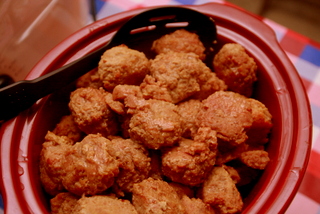
Ham Balls
This family favorite comes from Ginger Tribby’s mother, Ellen Dooley. Ginger and her sisters made a triple batch for this year’s Sept. 11 remembrance gathering.
1 pound ground ham
1 / 2 pound lean ground beef
1 / 2 pound lean ground pork
2 / 3 cup crackers, crushed
2 eggs
1 / 2 cup milk
1 / 2 cup finely chopped onions
1 / 2 teaspoon salt
1 / 4 teaspoon pepper
1 / 2 teaspoon liquid smoke
Syrup:
1 cup brown sugar
3 tablespoons vinegar
1 tablespoon water
1 teaspoon dry mustard
Combine all the ham ball ingredients. Shape into balls about the size of golf balls, and place in baking dish. Combine the syrup ingredients and set aside. Bake ham balls at 350 degrees for 30 minutes. Top the ham balls with syrup, and bake another 30 minutes.
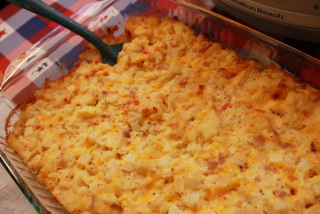
Cheesy Baked Hash Browns
This recipe from Joanne Gavin of St. Marys is always a hit at potlucks.
1 2-pound bag shredded hash browns
1 can cream of chicken soup
1 cup cheese (Velveeta or cheese in a can)
1 / 2 cup onions
1 / 2 cup peppers, diced
1 stick butter, softened
1 cup sour cream
Salt and pepper, to taste
Mix all ingredients together. Bake in an uncovered 9-inch by 13-inch dish at 325 degrees for 1 hour.
Macaroni Salad
This classic recipe is found in the “Great Home Cooking” cookbook compiled by members of the Immaculate Conception Parish in St. Marys.
3 cups macaroni (uncooked)
2 cups Miracle Whip salad dressing
2 / 3 cup sugar
2 cups cheddar cheese (shredded)
1 cup celery, diced
1 / 2 cup carrots (grated)
2 / 3 cup onion, diced
1 / 2 cup green pepper, diced
1 / 2 cup dried bacon bits
Mix Miracle Whip and sugar together with an electric mixer; set aside. Cook macaroni until tender. Drain and rinse in cold water; let cool. Combine Miracle Whip mixture with macaroni and all remaining ingredients. Refrigerate for two hours before serving. Makes 10 cups.
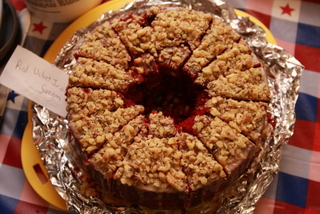
Rum Cake
This easy recipe from the Tribby’s friend Sheryl Reynolds of Des Moines tastes great with ice cream or whipped cream. It also freezes well. With a few minor adjustments (noted below the recipe here), it can be transformed into Red Velvet Irish Cream Cake.
1 cup chopped, toasted pecans or walnuts
1 15.25-ounce yellow cake mix
1 3.4-ounce instant vanilla pudding mix
4 eggs
1 / 2 cup cold milk
1 / 2 cup vegetable oil
1 / 2 cup Bacardi dark rum
Glaze
1 stick butter
1 / 4 cup water
1 cup sugar
1 / 2 cup Bacardi dark rum
Preheat oven to 325 degrees. Grease and flour a 12-cup Bundt pan. Sprinkle nuts on the bottom of pan. Combine all cake ingredients. Beat for 2 minutes on high with electric mixer. Pour into prepared pan. Bake for 1 hour. Cool in pan. Invert onto serving plate. Prick top with fork.
For glaze, combine butter, water and sugar. Boil 5 minutes, stir constantly. Remove from heat, and stir in rum. Note: the rum will cause steam, so be careful not to burn yourself. Drizzle glaze over top of cake. Use brush or spoon to put extra drippings of glaze on cake.
- To make Red Velvet Irish Cream Cake instead of Rum Cake, substitute 1 18.25-ounce box of red velvet cake mix instead of yellow cake mix. Also substitute 1 / 2 cup Irish Cream in the cake batter instead of rum. Follow all the same steps to prepare the cake. For the glaze, substitute 1 / 2 cup Irish Cream instead of the 1 / 2 cup rum. Follow all the same steps to prepare the glaze.
Slab Pie Bars
This recipe is a favorite of the Tribby’s neighbor, Holly Wiederin, who noted that it can be made with any berry or stone fruit. She likes to use pitted, tart cherries. This recipe makes one 17-inch by 12-inch sheet pan of bars.
For the crust:
5 cups all-purpose flour, divided
3 teaspoons coarse salt, divided
2 teaspoons sugar, divided
4 sticks cold unsalted butter, cut in to small pieces, divided
12 to 16 tablespoons ice water, divided
For the Slab Pie Bars:
All-purpose flour, for dusting
2 prepared crusts, from above
2 1 / 2 pounds (about 6 cups) fresh (or frozen, thawed & drained) berries, such as blackberries, blueberries, raspberries, or a combination
1 1 / 4 cups sugar
1 / 4 cup cornstarch
Juice of half a lemon (about 1 tablespoon)
1 / 4 teaspoon salt
2 tablespoon heavy cream
1 / 4 cup sanding sugar
For crust, process half of each of the flour, salt, and sugar in a food processor until combined. Add half of the butter. Pulse until mixture resembles coarse meal, about 10 seconds. With machine running, add about half of the ice water in a slow, steady stream just until dough comes together.
Turn dough out onto a piece of plastic wrap. Flatten dough, and shape into a rectangle; wrap in plastic. Refrigerate at least 1 hour or overnight. Repeat process with remaining ingredients – you need two discs of dough to make the Slab Pie Bars.
For the bars, preheat oven to 375 degrees. On a lightly floured surface, roll out a larger piece of dough to a 20-inch by 15-inch rectangle. Fit into a 17-inch by 12-inch rimmed baking sheet, pressing into corners. Pastry will hang over sides. Chill while assembling filling.
In a large bowl, stir together berries, sugar, cornstarch, lemon juice, and salt. Spread mixture over chilled pie shell.
On a lightly floured surface, roll out remaining piece of dough to an 18-inch by 13-inch rectangle; drape over filling. Fold edge of bottom dough over top dough. Pinch edges to seal. Prick top dough all over with a fork. Brush entire surface of pie with cream, and sprinkle with sanding sugar.
Bake until crust is golden brown and filling is bubbling, 40 to 55 minutes. Transfer to a wire rack, and let pie cool. Serve warm or at room temperature. Slab Pie Bars are best eaten the same day they are baked but can be kept at room temperature, loosely covered with plastic wrap, for up to two days. Slab Pie dough can be frozen for up to 1 month.
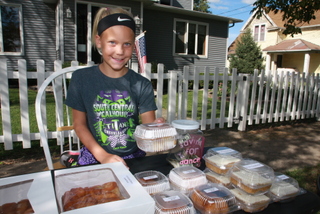
For the Love of Baking: Lake City’s Ellis Family Showcases Favorite Iowa Farm Recipes (Caramel Rolls, Pumpkin Bars and More!)
While some kids run lemonade stands, Tori Ellis, 11, sells homemade caramel rolls, pumpkins bars and more from a food stand in her family’s front yard along Main Street in Lake City. As she and her older sisters Aspen and Payton earn money for dance classes and dance competitions, they’re also learning the fine points of baking, using recipes passed on from their great-grandmother and grandmother.
“You k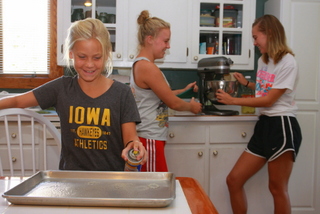 now it’s always good if you make it yourself,” said Aspen Ellis, 18, who is a senior at South Central Calhoun High School and reporter for the local FFA chapter.
now it’s always good if you make it yourself,” said Aspen Ellis, 18, who is a senior at South Central Calhoun High School and reporter for the local FFA chapter.
The Ellis girls learned to bake from their mother, Dannette (Smith) Ellis, who credits her mother, Jean, for teaching her learn how to cook. The Ellis family enjoy favorite recipes from the Smith and Schleisman sides of their family, including Grandma Loraine Schleisman’s famous caramel rolls and chocolate chip cookies. Other recipes, such as a creamy vanilla dessert and hearty beef stroganoff, are Dannette Ellis’ own creations. All have passed the Smith family’s “field test.”
“We take many of the things we make to the field at harvest or to the crew at our family’s hog barns,” said Dannette Ellis, whose girls get inspired by cooking shows like “Cake Boss” and “Good Eats” on TV.
Experimenting with new recipes is especially fun for Toi Ellis, who has sold homemade treats since she was seven years old. She’s glad her family bakes caramel rolls about every other week, since she has been known to sell 15 dozen in only three or four hours. “Baking makes the house smell like fall,” she said.
Savor more Iowa food history
Want more fun Iowa food stories and recipes? Check out my top-selling “Culinary History of Iowa” book from The History Press, and order your signed copy today.
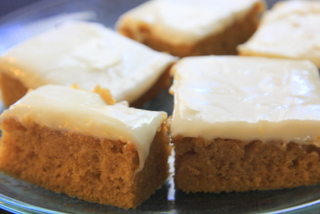
Dannette’s Pumpkin Bars
1 can pumpkin (or 2 cups fresh pumpkin)
2 cups flour
2 teaspoons baking powder
1 teaspoon baking soda
1 / 4 teaspoon salt
2 teaspoons cinnamon
2 cups granulated sugar
4 eggs
1 cup vegetable oil
1 teaspoon ground ginger
1 teaspoon pumpkin pie spice
Combine all ingredients. Bake in an 11-inch by 17-inch jellyroll pan for 20 minutes at 350 degrees. Frost with cream cheese frosting of your choice.
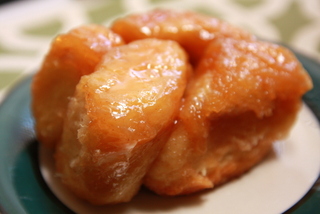
Grandma Schleisman’s Caramel Rolls
Don’t want to make caramel rolls? This recipe can also be used to make dinner rolls. Just don’t dip the knots of dough in a cinnamon-sugar mixture, and skip the caramel sauce.
2 cups granulated sugar
4 eggs
2 cups shortening or lard
3 teaspoons salt
1 cup mashed potatoes
1 teaspoon granulated sugar
4 packages yeast (2 1 / 4 teaspoons per package)
1 cup warm water, plus 5 cups warm water (or use potato water)
5 to 10 pounds flour
2 1 / 2 sticks of butter or margarine, melted
3 to 4 cups granulated sugar
Cinnamon, to taste
Mix together sugar, eggs, shortening, salt and mashed potatoes. (The Ellis family uses their large stand mixer for this process.) Set mixture aside.
Mix together 1 cup water, 1 teaspoon sugar and yeast in a glass bowl. Let mixture rise about 15 minutes.
Begin adding flour and water to mixture of sugar, eggs, shortening, salt and mashed potatoes. Add flour (a large spoonful at a time) and alternate with the 5 cups of warm water. Keep mixing and adding flour and water. When about half the water has been added to the dough, add the yeast water mixture. Continue to add flour and water until the water is gone and the dough begins to form a ball.
Turn the dough onto a floured surface. Knead the dough until it’s nice and smooth. Divide dough into two balls; place each one into large bowls that have been lightly greased with oil. Then cover each bowl with a damp towel.
Place bowls of dough in the warmest part of the house to let dough rise until it has doubled in size. Punch dough down. Cover bowls with a damp towel again. Let dough double in size once again.
Make the caramel topping (see recipe below). Pour caramel into 9-inch by 13-inch pans. (The caramel roll recipe makes 5 to 6 dozen caramel rolls. You can get 12 rolls into one 9-inch by 13-inch pan.)
In a bowl, combine the sugar and cinnamon. Melt butter or margarine in a separate bowl.
Punch down dough. Take a handful of dough and roll on the countertop. Form a strip of dough; then dip into the margarine and then into the cinnamon sugar. Tie dough into a knot. Place each knot on top of the caramel in the pan. Continue until dough is gone.
Bake each pan of rolls about 25 minutes, or until rolls are dark brown. The rolls need to be fairly dark on top in order for the middles of the rolls to bake properly. Cover rolls halfway through baking so the tops don’t get too dark. When baking is complete, let the rolls cool on the counter for about 2 minutes. Put tinfoil on top and flip pan over to invert. The pan should come off with no problem.
Let rolls cool. Store in air-tight plastic containers. Makes 5 to 6 dozen rolls.
Caramel Topping
2 / 3 cup brown sugar
1 / 4 cup margarine (Imperial brand margarine works well)
2 tablespoons corn syrup
Combine all ingredients in a sauce pan. Cook 1 minute, and then stir. Then cook 1 more minute. Pour mixture in bottoms of 9-inch by 13-inch pans.
Grandma Schleisman’s Famous Chocolate Chip Cookies
A mixture of shortening and butter help these cookies achieve the right shape and texture when baking.
1 1/3 cups shortening and butter (combine a mixture of roughly half butter and half shortening)
1 cup granulated sugar
1 cup brown sugar
2 eggs
2 teaspoons vanilla
3 cups flour
1 teaspoon baking soda
1 teaspoon salt
1 / 2 cup chocolate chips
Using a mixer, combine all ingredients except chocolate chips. Stir in chocolate chips by hand. Chill dough in refrigerator for 1 hour. Scoop out balls of dough onto baking stone or pan. Bake about 12 minutes at 350 degrees, or until cookies are nicely browned. Store cookies in air-tight container. These cookies freeze well, too.
Dannette’s Sugar Cookies
Almond extract adds a special flavor to these cookies, which work best when they are rolled out thin and are not overbaked.
1 cup margarine
1 1 / 2 cups powdered sugar
1 egg
1 teaspoon vanilla
1 / 2 teaspoon almond extract
2 1 / 2 cups flour
1 teaspoon baking soda
1 teaspoon cream of tartar
Cream margarine, powdered sugar, egg, vanilla and almond extract together until smooth. Add dry ingredients until well blended. Chill dough at least two hours, or overnight. Roll out dough on a floured surface to desired thickness. Cut dough with cookie cutters of your choice. Bake cookies on greased cookie sheet or baking stone at 350 degrees until bottoms and sides of cookies start to brown. Frost when cool.
Dannette’s Sugar Cookie Frosting
1 / 2 stick margarine
Dash of milk for right consistency
1 teaspoon almond extract
Powdered sugar (enough to make a nice, smooth frosting to coat the cookies)
Combine all ingredients together. Frost cookies, as desired.
Dannette’s Vanilla Dessert
This takes great on a crisp fall day with a warm cup of coffee.
1 / 2 cup walnuts
1 cup flour
1 / 2 cup margarine, melted
1 8-ounce contained whipped topping, reserve 1 cup
1 cup powdered sugar
1 8-ounce package cream cheese, softened
2 3-ounce packages instant pudding (any flavor is fine, although the Ellis family prefers vanilla)
3 cups milk
Chopped walnuts for garnish
For the first layer, combine walnuts, flour and margarine. Pat mixture into the bottom of a 9-inch by 13-inch pan. Bake 10 minutes at 375 degrees, and cool completely.
For the second layer, cream together 1 cup whipped topping, powdered sugar and cream cheese. Mix well. Spread over first layer in pan; chill.
For the third layer, combine pudding mixes and milk. Beat until thick. Pour pudding over second layer in pan; chill.
For the fourth layer, spread the remaining whipped topping over the third layer. Garnish with chopped walnuts. Refrigerate.
Dannette’s Beef Stroganoff
The Ellis family likes to serve this hearty stroganoff over mashed potatoes and cooked noodles.
2 pounds ground beef
1 / 2 cup chopped onion
3 cloves garlic
1 teaspoon beef bouillon
Salt, pepper, onion salt, garlic, meat tenderizer, to taste
1 can cream of mushroom soup
1 soup can of milk
1 / 2 cup sour cream
Brown ground beef in skillet. Drain fat. Add onion, garlic, beef bouillon, and seasonings. Cook until browned. Add cream of mushroom soup and milk. Cook for 5 minutes. When ready to serve, add sour cream.
I originally wrote this article for Farm News, Ft. Dodge, Iowa.

“A Culinary History of Iowa” Satisfies: Iowa History Journal Book Review
This terrific review of my latest book, “A Culinary History of Iowa: Sweet Corn, Pork Tenderloins, Maid-Rites and More,” from The History Press appeared in the September/October issue of Iowa History Journal. Enjoy!
Also, if you’d like to get your own signed copy of “A Culinary History of Iowa” or would like to send signed copies as gifts, click here to visit my online store. I appreciate your support for authors and Iowa-based small business!
Iowa has a long and substantial culinary history; far deeper than corn and pigs that are so often associated with our farm-rich state. “A Culinary History of Iowa,” written by Darcy Dougherty Maulsby, delves deep into its past, tracing as far back as the pioneer settlers for the story of food in Iowa.
From well-known names such as the Graziano Brothers, Blue Bunny ice cream and Maytag Blue Cheese, to hidden gems found in the most unexpected places, Iowa’s food culture is incredibly varied. As the book’s subtitle “Sweet Corn, Pork Tenderloins, Maid-Rites and More” suggests, there are unique flavors to be discovered across the state.
The book is an excellent primer on the roots of Iowa farmland, as well as current trends. Beginning with an overview of Iowa’s agricultural value and its products from American Indian traditions through the Great Depression and beyond, Maulsby concisely writes how Iowa history is tied to food creation, proliferation and consumption. The Iowa State Fair is a section unto itself, which befits the food-centric and beloved affair. A diverse gallery of local events (country fairs, sweet corn festivals) and modern confabs (Baconfest) are the beneficiaries of profiles, as well.
Finally, the book devotes space to the many long-established restaurants that can be found almost anywhere in Iowa; each with its own story to tell. It’s always fascinating to see history through a different lens, and Iowa’s culinary exploits definitely shine throughout these pages.
 Iowa has been influenced by many cultures in a variety of ways, but nowhere does that cultural melting pot shine so bright as in the kitchen. Polish, Swedish, German, Dutch and other culinary traditions are highlighted across multiple chapters in an exploration of what it means to be an immigrant in Iowa and how such cultures blend to create a far more ethnically diverse cuisine than many realize. Of all the observations and stories in the book, these wonderfully inclusive stories are among my favorites.
Iowa has been influenced by many cultures in a variety of ways, but nowhere does that cultural melting pot shine so bright as in the kitchen. Polish, Swedish, German, Dutch and other culinary traditions are highlighted across multiple chapters in an exploration of what it means to be an immigrant in Iowa and how such cultures blend to create a far more ethnically diverse cuisine than many realize. Of all the observations and stories in the book, these wonderfully inclusive stories are among my favorites.
This eclectic mixture of historical tidbits, social observations, vintage photos and delicious recipes provides just the right ingredients for a delightful reading experience. Maulsby, an Iowa native and lifelong food lover, has an obvious passion for her topic, and it pays off in this compact and charming book. She has worked across the state and Midwest for such diverse entities as Progressive Farmer magazine and the Iowa Turkey Federation.
Maulsby has written in many publications about Iowa food, and it’s clear that it is a labor of love and a collaborative labor as Maulsby solicited tales input from all across the state for the juiciest food-related tales and locations. Even those who are well acquainted with Iowa food lore are sure to find something new and interesting.
Ideal for anyone with a love of food history and particularly those with a Midwestern heart, this book has so many interesting tales, morsels of trivia and personal anecdotes that it feels as though the book should be twice as long. Go on an adventure with this fun, fascinating and tasty tale of culinary traditions that weave through Iowa’s past and present. Just be sure you have a snack handy.
(Julie Goodrich is a graduate of the University of Iowa and the University of Wisconsin. She works at Beaverdale Books in Des Moines, in addition to holding down a full-time job because she loves books.)
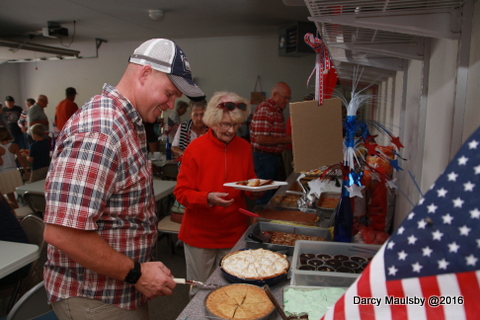
62 Years and Counting: Calhoun County, Iowa, Families Maintain 4th of July Picnic Tradition
Looking for deli fried chicken, bakery pies or other pre-made convenience food? Don’t be surprised if none of it turns up on the massive buffet on the Dial farm during the annual 4th of July picnic. I certainly didn’t see it at this year’s celebration.
“Everyone brings their A game to this event,” said Jolene Schleisman of Lake City, Iowa, who has been attending the 4th of July picnic since she was a child.
While my family has been attending the picnic each July for a few years, the event started in 1954 on Bud Burley’s farm near Lake City. Mike and Dorothy Nichols hosted the party the next year and maintained the tradition until 1981. Then their neighbors, Gerald and Alice Ann Dial, began hosting the celebration on their farm northwest of Lake City. In 2003, the event moved to the Dial’s son Dwight’s farm east of Lake City.
The celebration has been going strong ever since, attracting up to 50 or 60 guests each 4th of July. Along with the fireworks at dusk, the big attraction is the food. Countertops spanning the width of Dial’s two-car garage, along with additional tables, are loaded with homemade fried chicken, roast pork, casseroles, cheese potatoes, baked beans, salads of all kinds, deviled eggs, cakes, pies, candies and more.
“I appreciate how neighbors of all ages enjoy each other’s company,” said Laura Holm, a teacher from Ames who grew up on a farm near Lake City and brings her family back home for the picnic. “I also love the homemade, made-from-the-heart food that comes from friends’ kitchens, not store shelves. This party is about my roots, and I love to teach my kids about these roots.”
At this year’s celebration, Dial’s son, Andy, prepared a number of favorite recipes in honor of his late grandmother, Alice Ann Dial, including her famous lemon me
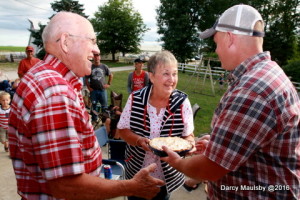
Andy Dial presents a lemon meringue pie to Jim and Joy Angove on their 50th wedding anniversary.
ringue pie. Schleisman also brought a number of classic dishes, including glazed ham balls. Oh yeah, that amazing Iowa classic that makes any picnic a little more memorable.
“To me and the Dial kids, the 4th of July picnic was better than Christmas,” Schleisman said. “I love it that this tradition continues.”
I couldn’t have said it better. Let’s eat!
Savor more Iowa food history
Want more fun Iowa food stories and recipes? Check out my top-selling “Culinary History of Iowa” book from The History Press, and order your signed copy today.
Fried Chicken
Andy Dial used his Grandma Alice Ann Dial’s recipe and his Grandma Dottie Loeck’s cast-iron skillet to make this fried chicken, which is always a star of the 4th of July picnic.
4 dozen chicken hind quarters separated into legs and thighs.
Breading:
5 cups all-purpose flour
1 1 / 2 teaspoons onion powder
1 cup whole wheat flour
1 tsp black pepper
4 tablespoons garlic salt
1 teaspoon paprika
2 tablespoons Lawry’s seasoning salt
Wash:
4 eggs
1 cup whole milk
Combine breading ingredients until mixed thoroughly. Place breading mix into a 9.5-inch pie pan. Beat eggs and milk together until mixed thoroughly. Place egg wash in a separate 9.5-inch pie pan.
Place chicken pieces first in the egg wash until liberally coated; then transfer to the breading mix and turn until coated fully. Once coated with breading, place chicken pieces into hot oil in frying pan. (Andy Dial prefers a cast-iron skillet.) Turn pieces ever 2 to 3 minutes until golden brown all over. Place into roaster pan at 350 degrees to finish cooking through and keep warm until serving time.
Note: To keep chicken crispy, serve immediately after frying.
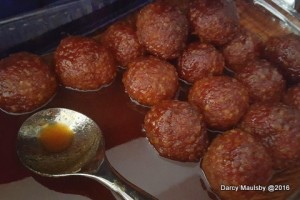
Glazed Ham Balls are an Iowa classic!
Glazed Ham Balls
Jolene Schleisman of Lake City uses 4 pounds of a ham-ball mix from the locker in Lake City to make these tasty ham balls. Her recipe shows how to make your own ham-ball meat mix, however. These ham balls can be made ahead and frozen (unglazed) to be baked later.
For the ham balls:
2 1 / 2 pounds ground ham
1 1 / 2 pounds ground pork
2 cups instant oatmeal or cracker crumbs
2 eggs, well beaten
1 cup milk
1 teaspoon ground pepper
For the glaze:
1 1 / 2 cups brown sugar
1 / 2 cup apple cider vinegar
1 teaspoon dry mustard
1 / 3 cup Cookies BBQ Sauce
1 / 2 cup water
2 tablespoons honey
Combine ground ham, ground pork, oatmeal or cracker crumbs, eggs, milk and pepper. Shape mixture into balls. Freeze the ham balls to bake later, or place them in a greased, glass baking dish.
To make the glaze, combine brown sugar, apple cider vinegar, dry mustard, BBQ sauce, water and honey in a saucepan. Cook over medium heat until sugar dissolves.
Pour glaze over ham balls. Bake for 1.5 to 2 hours at 275 or 300 degrees. About every 20 minutes, spoon the glaze over the ham balls as they bake. Yield: 32 ham balls
Deviled Eggs
Andy Dial used a recipe from his mother, Jane, to create this potluck favorite.
6 eggs
1 / 16 teaspoon pepper
2 tablespoons mayonnaise
1 / 4 teaspoon paprika
1 teaspoon vinegar
1 / 2 teaspoon dry mustard or 1 teaspoon prepared mustard
1 / 2 teaspoon salt
Slice hard-boiled eggs in half lengthwise. Remove yolks, smash and mix with seasonings. Refill egg whites with seasoned yolk mixture.
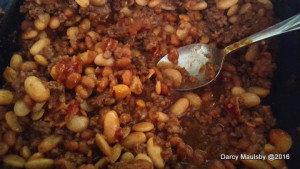
Calico Beans are healthy and always a hit at Iowa picnics.
Calico Beans
Jeanne Devine of Lake City brought along this potluck classic, which she created from a recipe on the Taste of Home website. This recipe can be easily doubled for a larger group.
4 ounces bacon, diced
1 pound lean ground beef (90% lean)
1 / 2 cup chopped onion
1 can (21 ounces) pork and beans
1 can (16 ounces) kidney beans, rinsed and drained
1 can (16 ounces) butter beans, rinsed and drained
1 / 2 cup packed brown sugar
1 / 2 cup ketchup
1 tablespoon cider vinegar
1 teaspoon prepared mustard
1 teaspoon salt
In a large skillet, cook bacon over medium heat until crisp. Remove to paper towels to drain. Discard drippings. In the same skillet, cook beef and onion over medium heat until the meat is no longer pink; drain. Combine the beef mixture, bacon, beans, brown sugar, ketchup, vinegar, mustard and salt. Spoon into a greased 2-quart baking dish.
Bake, uncovered, at 325 degrees for 45 to 60 minutes or until the beans are as thick as desired. Yield: 8-10 servings.
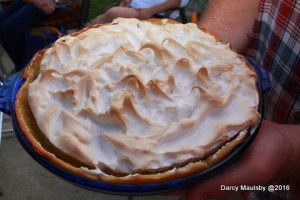
This homemade pie was inspired by Alice Ann Dial’s famous Lemon Meringue Pie.
Lemon Pie
Alice Ann Dial’s signature pie is distinguished by its fresh lemon flavor.
For the filling:
2 cups sugar
4 egg yolks
2 cups water
1 / 2 cup cornstarch
Dash of salt
8 tablespoons fresh lemon juice
2 tablespoons butter
For the meringue:
4 egg whites
8 tablespoons sugar
1 / 4 teaspoon cream of tartar
To mix the pie filling: Blend sugar, egg yolks, water, cornstarch and salt. Cook until the mixture thickens and bubbles up. Remove from heat and add lemon juice and butter. Pour the filling in a pre-baked pie shell made from Alice Ann’s all-purpose pastry mix (see recipe below) and cover immediately with meringue.
To make the meringue, beat the eggs whites until foamy. Add sugar and cream of tartar. Beat slowly until peaks form. Spread on pie, and bake the pie for 20 to 25 minutes at 325 degrees Fahrenheit.
All-Purpose Pastry Mix
Alice Ann Dial kept this all-purpose pastry mix on hand to save time when baking pie.
7 cups flour
4 teaspoons salt
2 cups lard
Combine all ingredients together to create a crumbled consistency, but make sure the mix doesn’t clump together. Store mixture in a covered container in the refrigerator.
For a single crust:
1 1 / 2 cups all-purpose pastry mix
3 tablespoons ice-cold water
For a double crust:
3 cups all-purpose pastry mix
5 tablespoons ice-cold water
Combine the all-purpose pastry mix and ice water until the mixture leaves the sides of the bowl. Then roll out the dough. If you’re making a pie shell for a lemon meringue pie, place the crust in a pie plate and prick the dough with a fork on the bottom and sides before baking the crust at 350 degrees Fahrenheit for 10 to 12 minutes.

Iowa Public TV’s “Market to Market” Features Expedition Yetter, Agri-Tourism, Des Moines Water Works’ Lawsuit
What do a water lawsuit, agri-tourism and good old Yetter, Iowa, (Everything’s Better in Yetter!) have in common? They are all part of my Expedition Yetter, which was filmed, in part, on my family’s Century Farm and featured on “Market to Market” on Iowa Public Television in the segment “Agri-Tourism in the Shadow of a Lawsuit.”
What fun we had, including Iowa Hawkeye football legend Chuck Long, who joined the group. Wonder what really goes on at an Iowa farm? Click here to watch the clip and ride along with the first-of-its-kind Expedition Yetter, which was designed to connect small-town and urban residents with the Iowa farms and agribusinesses where their food comes from.
Here’s a teaser from the show’s transcript:
Last year Iowa’s largest drinking water provider sued farm drainage districts in 3 counties upstream. As trial awaits in 2017, Des Moines Water Works has alleged excess nitrate runoff from farm fertilizers plagues efforts to comply with federal guidelines for safe drinking water. The utility claims cleaning the surface waters of the Raccoon River for half a million ratepayers in the capitol city vicinity has become an increasingly difficult and expensive task.
Bill Stowe/CEO and General Manager – Des Moines Water Works: “We’re very confident that these are clear point-source groundwater polluters that are coming from agricultural use.”
Ultimately, the case could redefine and broaden government jurisdiction over Waters of the United States – a prospect feared by many in farm country.
Darcy Maulsby/Expedition Yetter: “I’m not sure a lot of people in Iowa even knew where Calhoun County was before this lawsuit.”
Various producers, commodity groups, and politicians at the local and national level have called for widespread adoption of voluntary conservation methods to ward off new legislation.
But farmer and author Darcy Maulsby, who traces her lineage to a Century Farm near the small town of Yetter in one of the counties named in the lawsuit, hopes a dose of rural hospitality could mend fences.
Darcy Maulsby/Expedition Yetter: “I’ve noticed this growing trend towards this rift between rural Iowa and urban Iowa – and that really troubled me.”
Maulsby envisioned a journey bringing farm and city stakeholders together to help elevate the level of discourse. And after partnering with local non-profit Iowa Food & Family Project, the Iowa Soybean Association and several other food industry groups, tourists of diverse backgrounds loaded up in Des Moines early one summer morning for the maiden voyage of ‘Expedition Yetter.’
To read and watch the whole story, click here.
Explore more rural Iowa history
Want to discover more stories and pictures that showcase the unique history of small-town and rural Iowa? Perhaps you’d like a taste of Iowa’s culture and favorite recipes. Check out my top-selling “Culinary History of Iowa” book from The History Press and “Calhoun County” book from Arcadia Publishing, and order your signed copies today.

